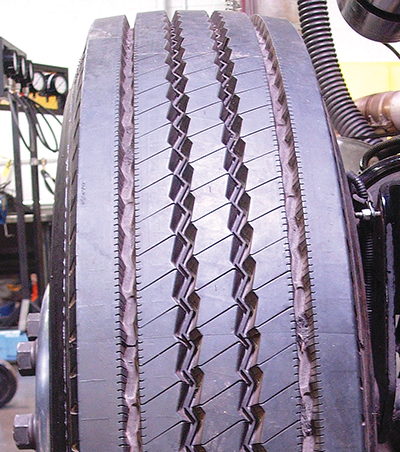By Christopher W. Ferrone
 A great episode from Seinfeld has Jerry musing about where the rubber on his BMW tires goes when it rubs off.
A great episode from Seinfeld has Jerry musing about where the rubber on his BMW tires goes when it rubs off.
This is truly an enigma. Like Jerry, it’s good to stop and remind ourselves of all that goes on with a set of tires. As tires wear, the material does in fact deposit onto the roadway and goes undetected because it happens so gradually.
The mechanical function of the tire casing is to contain the air pressure that supports the vehicle load, assure the function of the suspension by absorbing road irregularities, resist lateral drifting and centrifugal force, and transmit the torque necessary to move and stop the vehicle.
A number of factors affect the condition of a tire: the nature of its application for line haul, stop and go traffic (or a mix of both), the number of axles on the vehicle, overall maintenance of the tire during its life cycle and inflation pressure.
The major suspension and alignment adjustments control tire wear and condition. Technicians must monitor toe-in and toe-out, caster angle and camber angle. However, not all vehicles have a front axle that allows the control of these adjustments. Therefore, it is of vital importance to know the type of front axle on all vehicles and the allowable adjustments.
The most controlling factor in tire wear may be its inflation pressure. For every 10 psi a tire is under inflated, the life cycle of the tire is reduced by 10 percent. The amount of air in the tires affects the weight distribution between the wheels. An under-inflated tire does not carry its share of the load. This condition affects torque, traction, steering, alignment, braking and cornering, and may cause pulling from side to side.
A number of factors affect the condition
of a tire.
A tread separation usually means the tread has separated from the casing, disconnecting from the outermost steel belt. The outermost steel belt has become detached from the lower steel belt and the rest of the casing. Tread separation can be the entire tread or simply a section of the tread. This usually occurs later in the life of the tire casings unless a traumatic event has occurred.
A hole or some sort of damage that starts in the sidewall is normally the cause of a sidewall failure. Curbing the tire, striking a sharp object, age cracking and other structural issues all contribute to sidewall failures.
It is my belief that operators should never use retread or recapped tires on a motorcoach for any reason. When they experience failure they can damage the vehicle with the delaminated tread that is rotating with the tire casing, just as a circular saw would cut air hoses and suspension bellows during this type of failure.
Typically, the life cycle for a tire is four to six years, which corresponds to the average useful life of a tire casing. Despite the condition of the tread, tires should be taken out of service when they reach the four to six year mark. The DOT number embossed on the side of the casing notes the age of the tire. The last three numbers indicate the week and year of manufacture.
Technical staff must understand what affects tire condition and respond proactively. They must routinely monitor wheel alignment, inflation pressure and suspension adjustments in order to maintain proper tire performance. Additionally, if the vehicle has a steerable tag axle, technicians must also monitor those components to ensure the expected life cycle for the tag axle tires.
